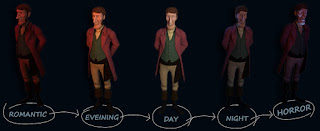Lighting and shading are two crucial phases of character creation in gaming. Whether it is a simple puzzle game or a complex one that involves cars and guns, lighting and shading play a decisive role in setting up the mood and atmosphere of a game. For instance, if it’s a thriller or mysterious game, then it must keep players on the edge of their seats. Such games will have darker environments and shady objects often punctuated with surprising elements.
However, both these Game Development Companies techniques require in-depth study with hands-on experience. In fact, it takes years of practice before one can master the subtleties of lighting and shading skills. As an avid and keen gamer, if you closely check the credits of any good game, you’ll find that almost each of them features at least one lighting director who makes sure that the graphics have perfection in terms of light.
Surprisingly, most gamers and investors of the gaming industry are still unaware of the importance of these skills. But if you need to make your game work, you must have at least a fair idea about the basic skills needed for game development, and lighting and shading are two of them. Listed below are a few key roles played by lighting and shading skills in the creation of attractive game characters.
– Blending of Characters with Background
For a game to look as real and natural as possible, it’s important that characters blend naturally with the background. Shading and Lighting Techniques of characters along with the scene helps in proper blending. This task requires ultimate precision for one needs to have a sharp eye for coloring and proper layering of characters. For instance, when you are working on characters with a background as daylight, you need to add a tint of blue to the shades because outdoor shadows usually have a bluish touch lasting from morning till afternoon.
Such intricacies in a game are designed and developed through lighting and shading, and this is just one simple example. There are countless such details in a character in which lighting and shading take care of, which is why proficiency in these skills is important.
– Provide Depth to Characters
Shading in gaming or, in general, in computer graphics is used for the depiction of depth. Basically, shading is extensively used in paper drawings for highlighting darker and lighter areas with pencils. This also holds true while creating gaming characters. It provides depth and dimension to characters.
The difference is that while for papers, pencils alone can do the work, for gaming, this depth, dimension, and differentiation in 3D Character Modeling is achieved with the help of lighting along with shading. While rendering a scene, a gamer usually has to use different lighting techniques like ambient, directional, spotlight and area. Different techniques are used along with shading to get different effects on the characters.
– Prominence to Texture
Texture is another important feature that gives clarity to characters. If you have ever played games of super heroes, then you must have some experience with capes, masks and super powers. As a gamer, you must have noticed how realistic the cape looks when it flows in air or when they strike with super powers. You are able to see the soft textures over smooth surfaces and how sharp objects when used in the Game Art Design show distinctive changes with the slightest movement.
These subtle changes that you are able to notice in a game are because of proper texturing, but what gives prominence to the texture is lighting. That’s how you are able to see those small changes while the characters are in movement.
Summing Up
Lighting and shading game characters is no cakewalk. As already stated, these skills require years of practice and proficiency. So if you wish your gaming Character Modeling Artist to stand out, team up with animation studios which can provide you with competent game designers and developers.

No comments:
Post a Comment